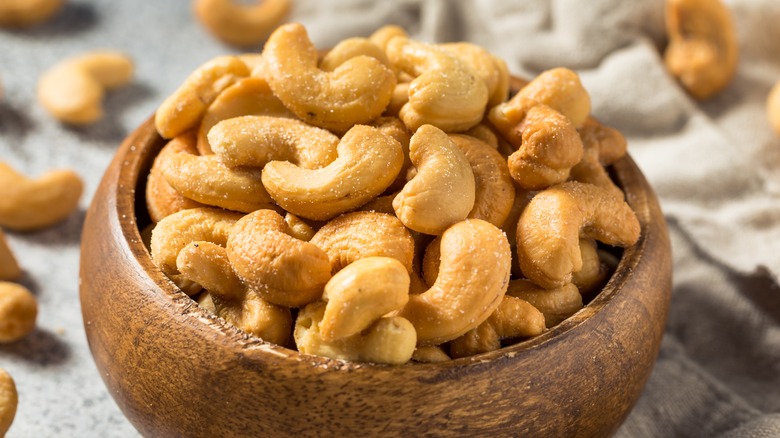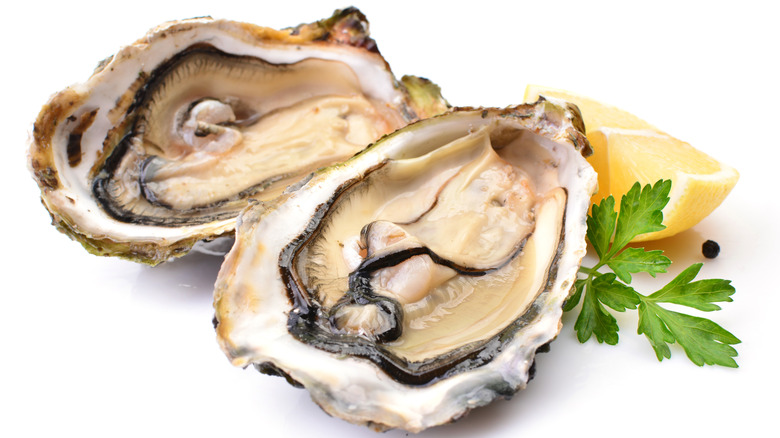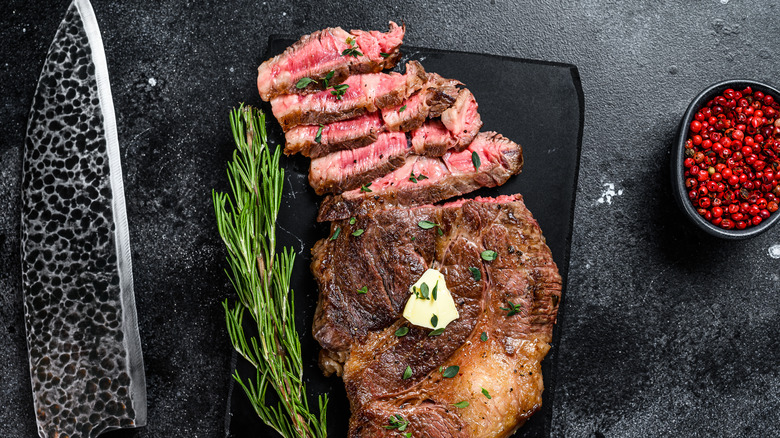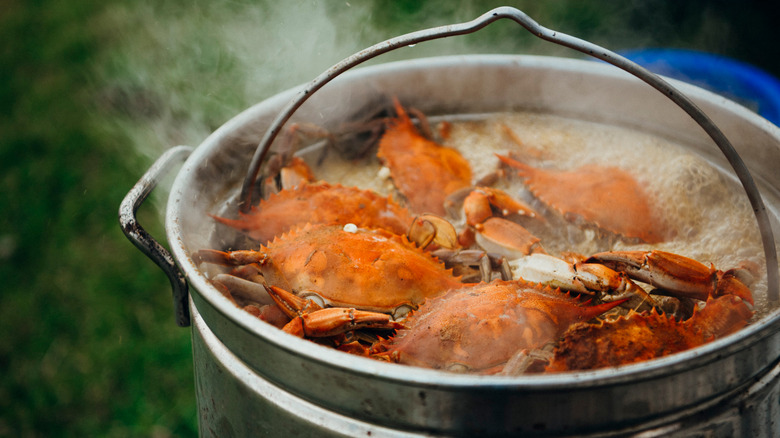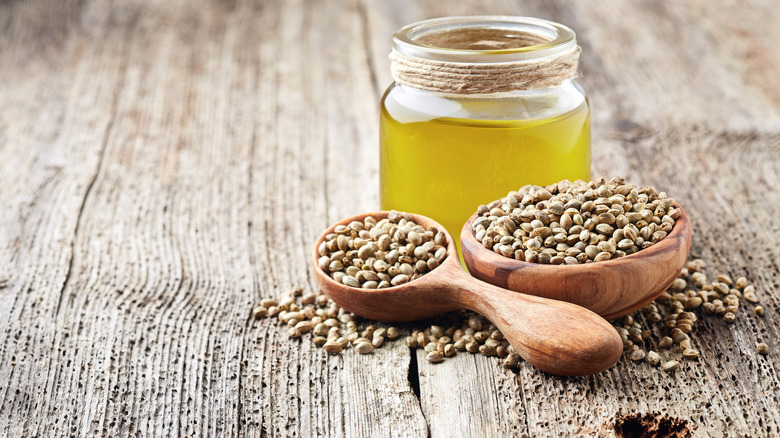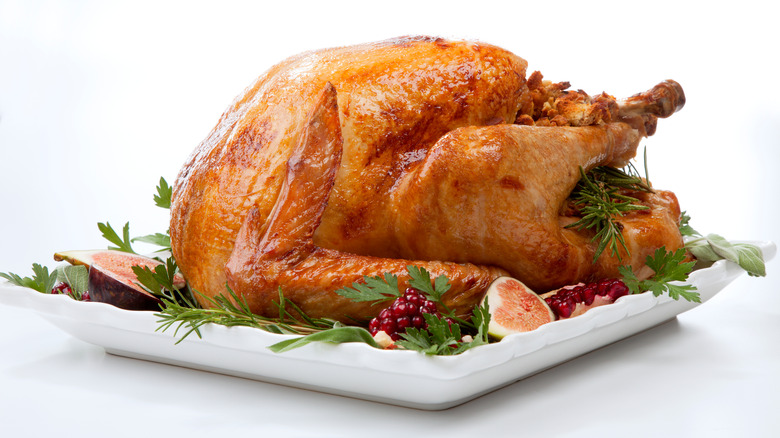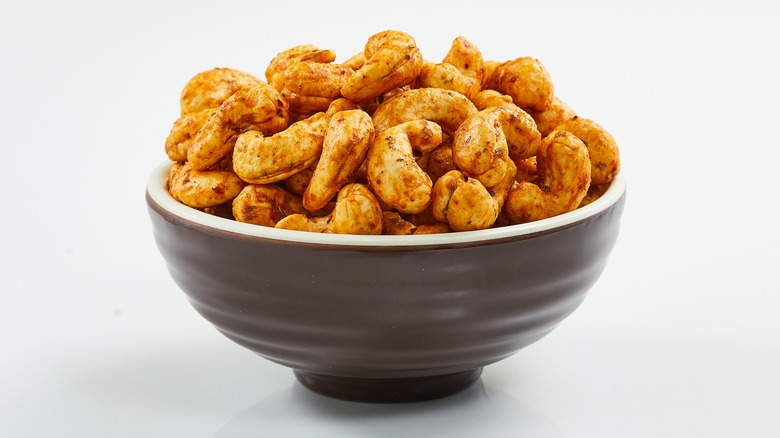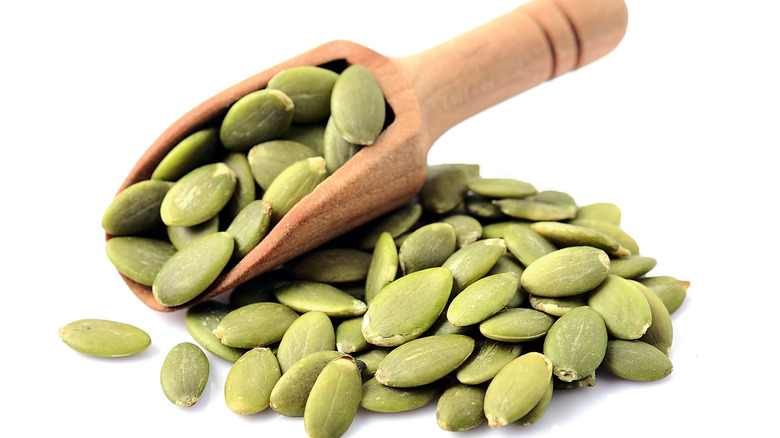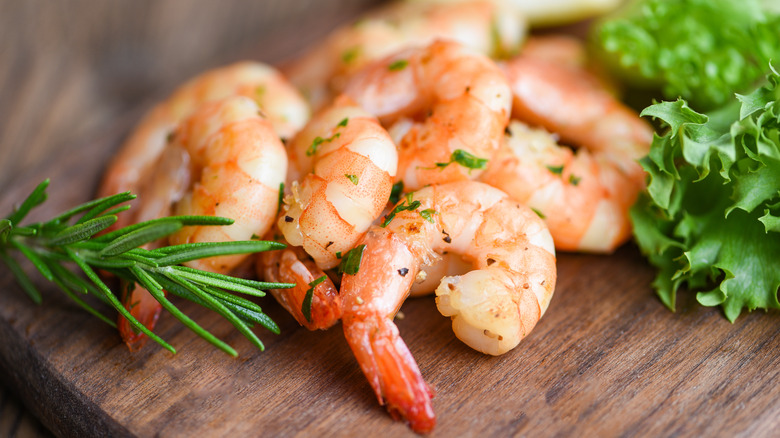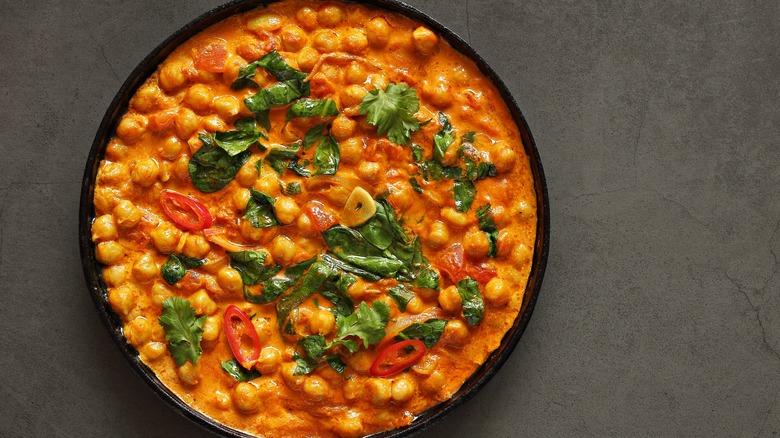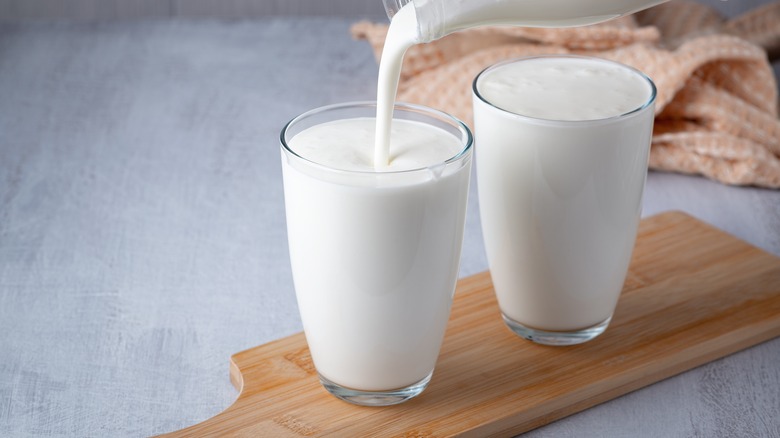10 Foods You Should Be Eating For More Zinc
Zinc is an essential part of our world, quite literally. The 24th most common element found in the Earth's crust, it is also common in ocean water and soil. It's also an essential mineral for human health. A human fetus can't develop properly without zinc (via Periodic Table), making it a critical nutrient for pregnant women, according to Midwifery Today.
Zinc is an essential micronutrient, meaning the human body requires it for survival, but only in small amounts (via the World Health Organization). Zinc impacts enzyme and hormone production, growth and development, immune system functioning, energy levels, protein production, wound healing, and even mental health. WHO public health nutrition education is focused on micronutrient deficiency prevention for these reasons, especially in lower-income countries where populations are most at risk.
Zinc deficiency is uncommon, but certain health factors create deficiency risk, such as pregnancy, vegetarianism, pregnancy, lactation, sickle cell disorders, or alcohol use disorders (via Forbes Health). However, consuming too much zinc can lead to zinc toxicity, marked by symptoms like nausea, appetite loss, headache, diarrhea, and cramps. Consult your health care provider before making a decision about zinc supplementation. Signs of deficiency may include poor appetite, low mood, decreased immunity, delayed wound healing, a lack of smell or taste, diarrhea, or hair loss (via Harvard T.H. Chan School of Public Health). So, where do humans get zinc? Let's explore the zinc-rich foods to include in your diet for health and vitality.
1. Oysters
The oyster has an interesting history in the Americas. British colonists arriving on the eastern coast of North America were fascinated to discover oyster shell mounds and even forged treaties and agreements early in settlement history to gain access to the oyster beds used by Indigenous Americans. Oysters were so beloved that, on the East Coast, around 700 million were consumed yearly by 1880. Since oysters could not be easily transported prior to electric refrigeration, in many parts of the U.S., they were largely consumed during winter months in Christmas oyster stews.
Today, oysters are a favorite beach vacation destination food or appetizer served with white wine and are readily available for the home cook. This is a good thing, since oysters have far more zinc than most foods, at 74.1 milligrams per 3-ounce serving, which is 673% of the recommended daily value! Consuming even just a few oysters provides enough for the human body to reap zinc benefits such as increased immunity and healthy enzyme functioning. Remember this the next time you cook up a paella or chowder or want to create a tasty but nutritionally beneficial appetizer menu.
2. Beef
Beef consumption is responsible for roughly 20% of the zinc intake in the United States, and the U.S. is the largest consumer of beef in the world. Americans love their red meat — but what do we need to know about beef and zinc? Well, beef in general is a good source of zinc. For example, roasted bottom sirloin contains 3.8 milligrams per 3-ounce serving, which will get you about 35% of the recommended daily value.
Since beef is palatable to most Americans and is easy to incorporate into a variety of recipes, it can be an easy way for both adults and children to get zinc. Consumers should also, however, be aware that research has long indicated that diets high in red meats such as beef are linked to increased risk of a variety of chronic diseases, such as heart disease and cancer, as noted by a review in the Journal of Internal Medicine.
3. Crab
Crab and other crustaceans offer a host of critical nutritional elements for the human body, including omega-3 fatty acids, protein, magnesium, iron, B vitamins, and zinc. Crabmeat offers these beneficial nutrients without the health risks presented by red meat. For this reason, Harvard School of Public Health nutritionists recommend swapping red meat out for seafood like crab where possible, such as in sandwiches, salads, or casseroles. A 3-ounce serving of nutrient-dense blue crab, for example, provides around 29% of an adult's daily recommended zinc.
For those who like to avoid beef for ethical reasons or prefer a semi-vegetarian diet, crab may also be a wise consideration for long-term health. As plant-based meat products become more commonly marketed, though, consumers should keep in mind that there is some concern about the lack of essential nutrients like zinc in plant-based diets that consumers may believe are healthy. A study published in Nutrients found that many meat substitutes are lower in zinc.
4. Hemp seeds
Hemp seeds can be a good source of food zinc, especially for vegans. A 3-tablespoon serving of hemp seeds can provide about 3 milligrams of zinc, which is a significant portion of the recommended 8 to 11 milligrams per day recommended for adults. Hemp seeds are also a rare source of comprehensive plant-based protein, providing all nine of the essential amino acids that we can only access through food. Hemp comes from the cannabis plant, but it has almost no active tetrahydrocannabinol (THC). An increasingly popular superfood, hemp is also remarkable in that it is a very easy food to digest and its nutrient content is readily absorbable. As hemp has been increasingly used and marketed as a food, supplement, and cosmetic ingredient in recent years, the United States Department of Agriculture has even developed the Domestic Hemp Production Program.
"These seeds are nutritional powerhouses and can add a sneaky and easy protein source to smoothies, yogurt parfaits, oatmeal bowls, energy bites and more," Registered Dietitian Stefani Sassos tells Good Housekeeping.
5. Turkey breast
Turkey, the beloved Thanksgiving staple that is associated with cozy holiday imagery and Norman Rockwell charm, is known as a healthy protein option — and for good reason. Turkey isn't just for holiday entertaining, however. It can provide nutrition benefits for you and those you love year-round as part of a zinc-rich diet.
"Turkey is a great source of protein, rich in many vitamins and minerals, and is low-fat — if you don't eat the skin," Catherine M. Champagne, professor of nutritional epidemiology and dietary assessment and nutrition counseling at the Louisiana State University Pennington Biomedical Research Center, tells the American Heart Association. Besides being rich in protein and B-complex vitamins and low in fat, turkey is high in essential minerals like zinc. One 4-ounce serving contains around 2.6 milligrams of zinc. As long as skin is minimally consumed and sodium use is taken into account, turkey can be a healthful food source of zinc.
6. Cashews
Tree nuts are generally very nutrient-dense, packed with protein, fiber, vitamins, and minerals. Just 1 ounce of cashews can provide about 15% of your daily value of zinc. For those without nut allergies, these nuts can be an easy way to sneak more zinc into your diet. Native to Brazil, cashew trees were brought to India and Africa via Portuguese colonists. They soon spread throughout Southeast Asia.
Cashews are commonly consumed in baked goods or sweets or as a snack but can be included in stir-fries and savory dishes or eaten as a nut butter. Snacking on or cooking or baking with cashews can be an easy way to incorporate more zinc into your family meals. This is important, since research published by StatPearls (via the National Center for Biotechnology Information) shows that a diet with a healthy dose of zinc supports the body's metabolism of proteins, lipids, and nucleic acids and additionally aids in immune function, wound healing, and even reproductive processes.
7. Pumpkin seeds
Pumpkin seeds are another great seed to eat for added zinc. Some of us only consume pumpkin seeds as a fall treat, lightly salting and baking them after a fun evening of pumpkin carving with the family. Pumpkin seeds can also be easy to incorporate into your daily meals year-round, for example by sprinkling them onto yogurt, into salads, or onto your morning oatmeal. One serving of pumpkin seeds contains roughly 6.6 milligrams, or around half your daily requirement of zinc, making them a beneficial snack for reducing body inflammation and for proper immune functioning, along with the many other health benefits of proper zinc intake (via the American Heart Association).
According to a 2022 research review written up in the journal Plants, despite pumpkin seeds' common reputation as a by-product of carving a jack-o'-lantern, one that might end up in the trash or on the compost heap, they are perfectly safe to eat, with no ill effects associated with regular consumption. They also provide a range of nutrients in addition to zinc, such as magnesium, phosphorus, potassium, and selenium, making them potentially beneficial for those suffering from ailments ranging from prostate cancer to arthritis.
8. Shrimp
Who doesn't love a shrimp cocktail appetizer while chatting at a party or charred, grilled shrimp at a summertime cookout? Shrimp are an excellent source of protein, B-complex vitamins, omega-3s, antioxidants, and minerals, including zinc. A 3-ounce serving of shrimp contains only 84 calories but 20 grams of protein, not to mention 1.4 milligrams of zinc. Although some worry that shrimp is high in cholesterol, experts say that the benefits of eating shrimp outweigh the risks. Jenny Shea Rawn, MS, MPH, RD explains to EatingWell, "The saturated and trans fats we consume impact our cholesterol levels more than dietary cholesterol — and shrimp contains minimal saturated or trans fats."
Americans typically eat more shrimp than any other seafood — an average of about 4 pounds of shrimp yearly, to be exact. If you include shrimp in your diet as a source of zinc, be sure to avoid shrimp with a strange or ammonia-like smell, as this can signify bacteria growth (via the Chicago Tribune).
9. Chickpeas, lentils, and beans
Chickpeas, lentils, and other beans such as black-eyed peas are a wonderful source of zinc for vegetarians or vegans. One cooked cup of chickpeas can provide the body with 2.5 milligrams of zinc. Lentils also pack 2.5 milligrams, aka 23% of the recommended daily value, per cup. Legumes and beans are notably heart-healthy diet additions (via the American Heart Association). They are also packed with non-animal protein. (The chickpea, for example, is protein-rich, at over 14 grams per cup).
Full of fiber, they are filling and also offer a wide variety of potential recipes to explore. Soups, stews, casseroles, spreads, dips, and salads can be easy vehicles for incorporating chickpeas, lentils, or beans for increased zinc consumption. These foods are also easy to store in dried form and make affordable protein options. Check out your local grocery store's bulk section to buy dried chickpeas, lentils, or beans at the most economical prices per weight.
10. Yogurt and kefir
Kefir and yogurt are commonly touted for digestive benefits among health food enthusiasts (via Healthline). Both are created by fermenting milk. Beyond being good sources of protein, both offer probiotics, calcium, phosphorus, B12, vitamin D, magnesium, and zinc. Several ounces of plain yogurt contain around 1.2 milligrams of zinc, which is about 13% of an adult's daily recommended value. Yogurt is a great zinc-rich snack for children, pregnant women, teens, or the elderly, since it's easy to grab and take. (An estimated 17% of the world population is at an increased risk for zinc deficiency; for the elderly, that number jumps to 40%.)
Yogurt and kefir make great choices for aging and growing populations because of their bone-supporting calcium, mineral, and vitamin D content, in addition to zinc content. Yogurt and kefir also both come in various flavors, but be sure to read food labels to check for added sugar content.
